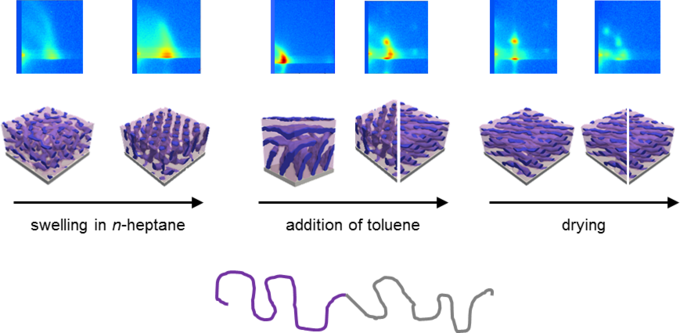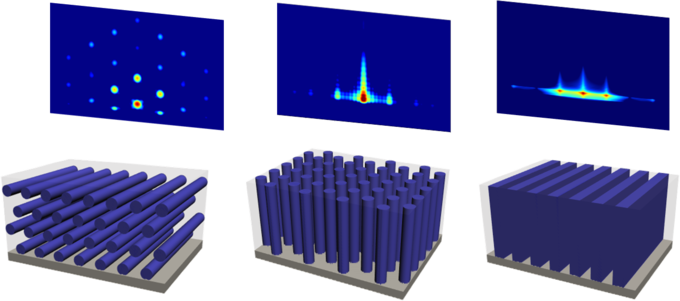Controlling morphologies at the nano-scale
Nano-structure of thin polymer films is precisely controlled by new type of annealing
2018-05-08 – News from the Physics Department

Polymer films are commonplace and have many technological applications in different fields. These include resist layers in lithography, sensors, or as lubricants, to name a few. Depending on the actual use, many have complex nano-structures created from different kinds of polymers, i.e. ordered structures on a scale that is in the range of a few nanometers. Such nano-structured thin films may be used in chip fabrication, replacing the currently used optical mask technology. Worldwide, many groups are currently developing such nano-structured resists. Methods which give flexible access to such nano-structured films of a given morphology are highly seeked.
Obtaining nano-structures by self-assembly
Polymers are macromolecules, that consist of many (hence “poly”) smaller units, the monomers. In ordinary polymers, all monomers are identical. Diblock copolymers (DBCPs) are a special kind of polymers, consisting of two chemically different polymers that are chemically bound to each other.
Regarding the overall structure, one interesting property of diblock copolymers is a phenomenon called microphase separation: At certain circumstances, it is favourable for the two blocks to demix. Since the two blocks are chemically bound to each other, this phase separation can only occur locally. This way, structures on the scale of a few nanometers are formed, for instance, cylinders on a hexagonal lattice or lamellae.
Such nano-structures can be obtained by self-assembly during the preparation of the films from solution, i.e. no sophisticated and expensive technologies for nano-patterning are required. However, the resulting thin films often lack long-range order. Thus, post-treatment is required, such as annealing with solvent vapors. However, it may be difficult to find a suitable solvent for a given block copolymer - it must have a sufficiently high vapor pressure and a suitable selectivity for one of the blocks in the block copolymer. Moreover, it must be compatible with the given production environment.
Using two solvents for annealing...
The group of Professor Christine M. Papadakis at TUM’s Physics Department have found a solution to overcome these limits: In their current work published in the journal “Advanced Functional Materials”, they demonstrate that using mixtures of solvents in solvent vapor annealing on block copolymer thin films gives many more possibilities to fine-tune their nano-structure.
... achieves installing different morphologies

By changing the mixing ratio of the two solvent vapors step by step, the internal structure of the film was modified from the initial cylindrical, hexagonal morphology into a lamellar (layered) one. These structural changes were recorded in-situ and in real time. Since the observed structures are too small to be imaged directly by light, a more refined technique was required: Grazing-incidence small-angle x-ray scattering (GISAXS) allows to study structures as small as a few nanometers.
The periodic cylindrical or lamellar nano-structures lead to characteristic Bragg reflections. Several questions arose: How much solvent does the block copolymer thin film contain? How are the two types of solvents distributed among the two types of nanodomains? Which vapor composition is needed in order to swell the cylinders sufficiently so they are transformed into lamellae? These questions could be answered by carefully analyzing the Bragg reflections and by complementary computer simulations.
The newly developed concept may be applied to other functional polymer-solvent systems. Improving the understanding of solvent vapor annealing of such films greatly helps in optimizing the treatment conditions to obtain films suitable for application.
Further information
This work is a result of the close collaboration of Prof. Christine M. Papadakis with Prof. Dorthe Posselt (Roskilde University, Denmark) and Prof. Detlef-M. Smilgies (Cornell High Energy Synchrotron Source, Cornell University, USA).
The research was funded by the German Research Foundation (DFG), the Danish Centre for the Use of Synchrotron X-ray and Neutron Facilities (DANSCATT), and the Master in Materials Science Exploring Large Scale Facilities master program (MaMaSelf). This work is based upon research conducted at the Cornell High Energy Synchrotron Source (CHESS). The Supercomputing Center of Moscow State University provided access to the supercomputer Lomonosov, where computer simulations were performed.